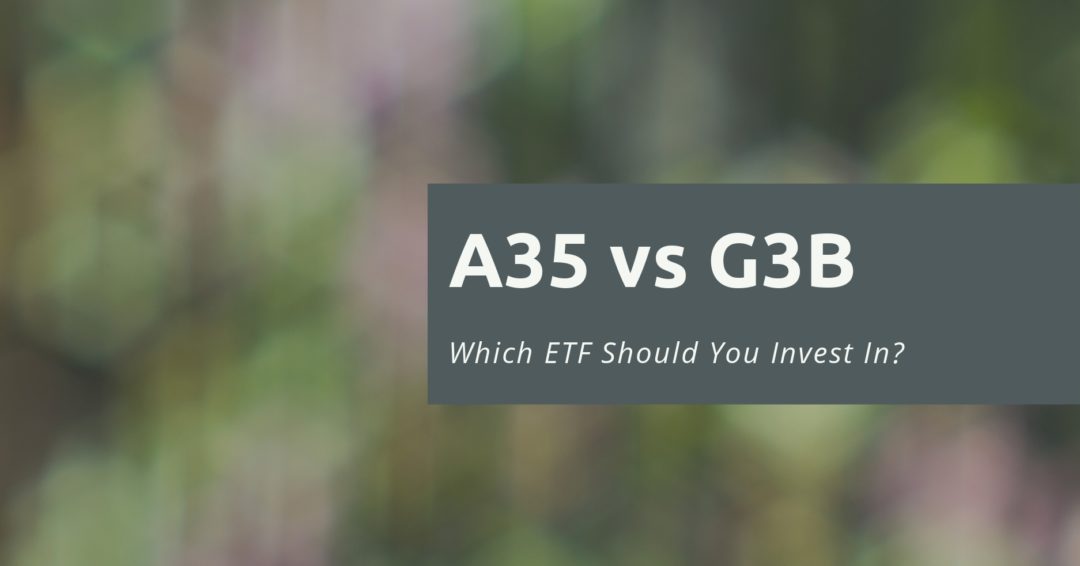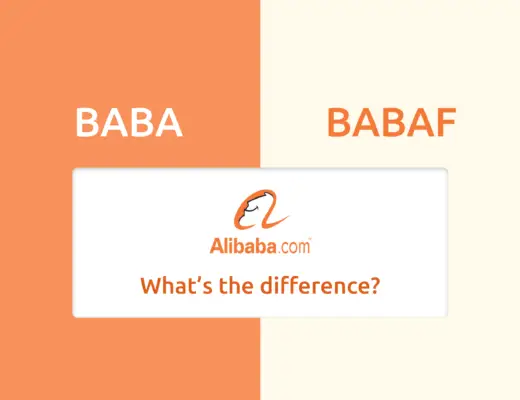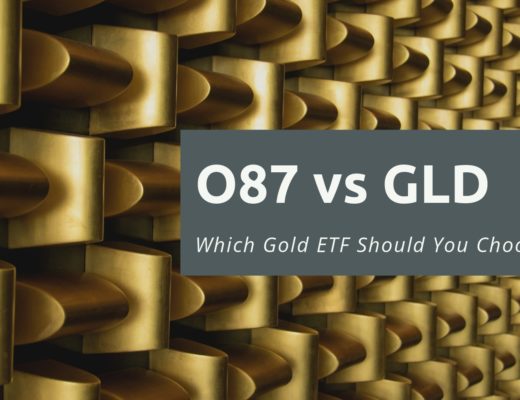Last updated on June 17th, 2021
You’ve decided to invest in a Singapore ETF. However, there are quite a few for you to choose from!
Two of the more popular ETFs include the ABF Singapore Bond Index Fund ETF (A35) and the Nikko AM STI ETF (G3B).
How are they different and which one should you be choosing?
Contents
The difference between A35 and G3B
The ABF Singapore Bond ETF (A35) invests mainly in bonds, while the Nikko AM STI ETF (G3B) invests in stocks. You will receive more stable returns with A35, while your returns with G3B may be more volatile.
Here is an in-depth comparison between these 2 ETFs:
Fund manager
Both A35 and G3B are managed by Nikko Asset Management (AM).
The ABF Bond ETF was started in August 2005, while the STI ETF only started in February 2009. With these extra 4 years, A35 has a larger assets under management (AUM).
| ES3 | G3B | |
|---|---|---|
| AUM | $1,001 million | $512 million |
Index tracked
Both ETFs track 2 different indexes:
A35 tracks the iBoxx ABF Singapore Bond Index
The ABF Singapore Bond ETF tracks the iBoxx ABF Singapore Bond Index. This index tracks bonds that are issued by:
- Singapore or other Asian Governments
- Agency or instrumentality of Singapore or other Asian Governments
- Sponsored entities of Singapore or other Asian Governments
- Quasi entities of Singapore or other Asian Governments
- Singapore dollar denominated debt obligations issued by supranational financial institutions
The countries included in the ‘other Asian Governments‘ are:
- Singapore
- China
- Hong Kong
- Indonesia
- Korea
- Malaysia
- The Philippines
- Thailand
The top holdings of this fund are mainly Singapore government bonds.
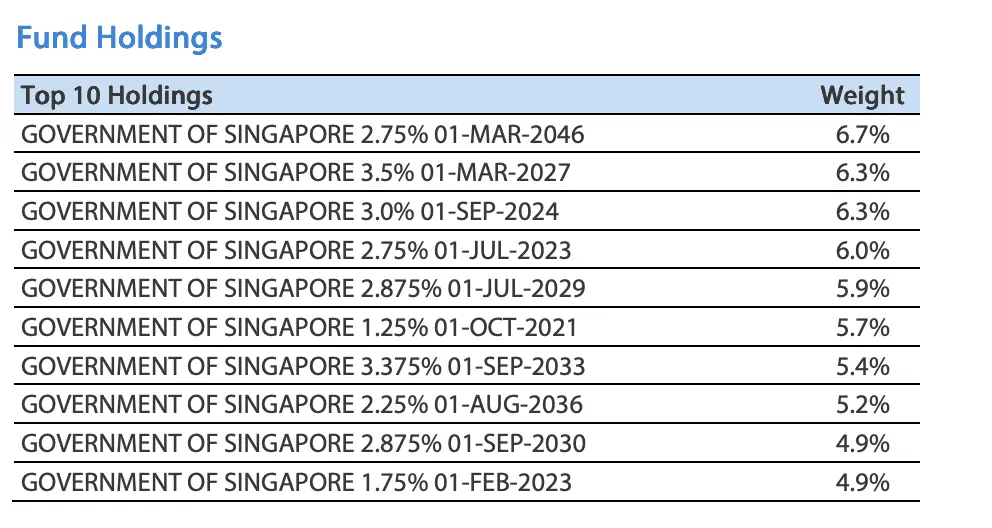
And most of the bonds are concentrated in Singapore.
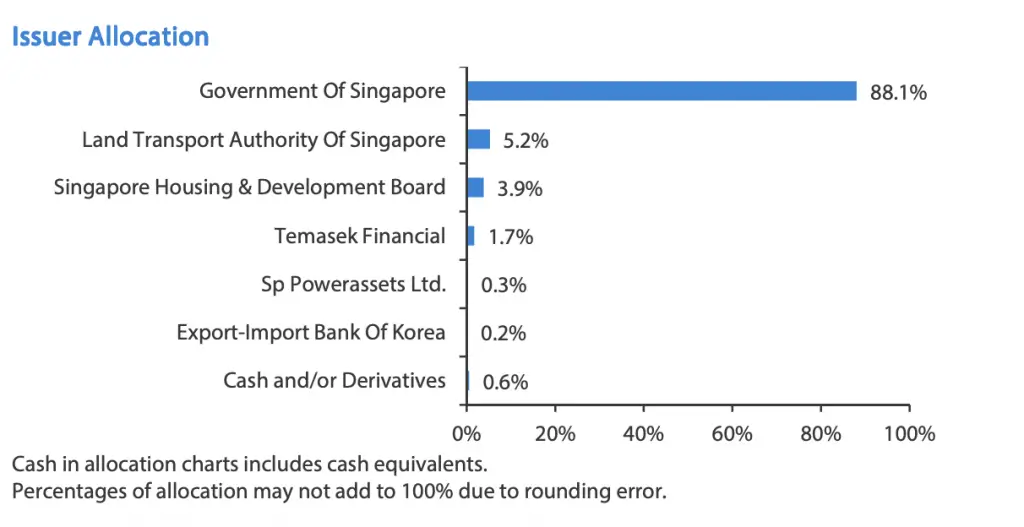
The average credit rating for these bonds are AAA. This means that the risk of the bond defaulting is very low. As such, this makes A35 a very safe investment option for you!
You can see how A35 differs from another bond ETF (MBH) that is listed on the SGX too.
G3B tracks the Straits Times Index (STI)
The Nikko AM STI ETF track the Straits Times Index (STI).
The Straits Times Index (STI) is a market capitalisation weighted index that tracks the performance of the top 30 companies listed on SGX.
This index will include the top performing 30 stocks that are listed in the SGX. Here are some of the top holdings of this index:

The Nikko AM STI ETF is just one of the 2 STI ETFs that are listed on the SGX. The other one is the SPDR STI ETF that is managed by State Street Global Advisors.
Estimated unit price
Here are the estimated unit prices for these 2 ETFs:
| A35 | G3B | |
|---|---|---|
| Estimated Unit Prices | $1 | $3 |
Since both ETFs have quite a low unit price, this makes it very accessible for you to purchase one unit.
If you are investing with a broker, the minimum lot size is 10.
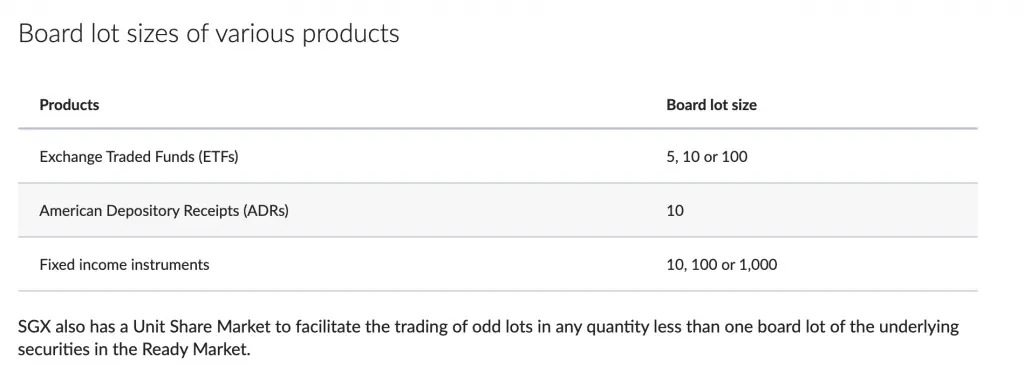
This is still rather accessible as you’ll only need to pay a maximum of around $30 to own 10 units.
However, you’ll need to consider the trading commissions charged by the broker. If the broker has a minimum commission for each trade (e.g. $10), then it may be very costly to invest only a small sum!
Dividends
A35 distributes its dividends each year. This is usually done in the first week of January each year.
In contrast, G3B distributes their dividends every 6 months.
While A35 is considered as a fixed income fund, you will only receive the distributions once each year!
Expense ratio
One of the costs that you’ll incur when investing with an ETF is the fund’s expense ratio.
The expense ratio is charged by the fund manager to cover the costs of running the fund.
Based on the value of your assets in the fund, you will be charged an annual fee.
Here are the expense ratios for both ETFs:
| A35 | G3B | |
|---|---|---|
| Expense Ratio | 0.25% | 0.3% |
The expense ratio for A35 is slightly lower than G3B.
However, the expense ratios of these 2 ETFs are quite high, compared to S&P ETFs which charge less than 0.1%!
Performance
A35 tracks a bond index, while G3B tracks a stocks index. When you compare the performance of these 2 ETFs, you may expect G3B to be doing better.
When you look at the 5 year performance between G3B and A35, G3B has performed only slightly better.

The Straits Times Index has been unable to recover back to its all-time high in 2018!
However in the long run, G3B should be able to give better returns compared to A35.
Average trading volume
If you are looking to actively trade using these ETFs, you may want to look at their liquidity. One of the indicators you may want to look at is the ETF’s trading volume.
| A35 | G3B | |
|---|---|---|
| Average Trading Volume | 389,000 | 454,000 |
Both ETFs have a rather similar trading volume.
Methods to invest
There are a few ways that you can invest in these 2 ETFs:
#1 Brokers
There are few brokers which allow you to trade stocks and ETFs that are listed on the SGX. Some examples include:
- DBS Vickers
- FSMOne
- Tiger Brokers
- UOB Kay Hian
- OCBC Securities
You can view my comparison between Tiger Brokers and FSMOne to see which one is more suitable for you.
If you use any of these brokers to perform your trades, you will be able to purchase either ETF.
The minimum number of units you can purchase for each ETF is 10
SGX is unlike the NYSE or London Stock Exchange, where the minimum number of units you can purchase is 1.
Instead, the minimum lot size you can purchase for either ETF is 10.
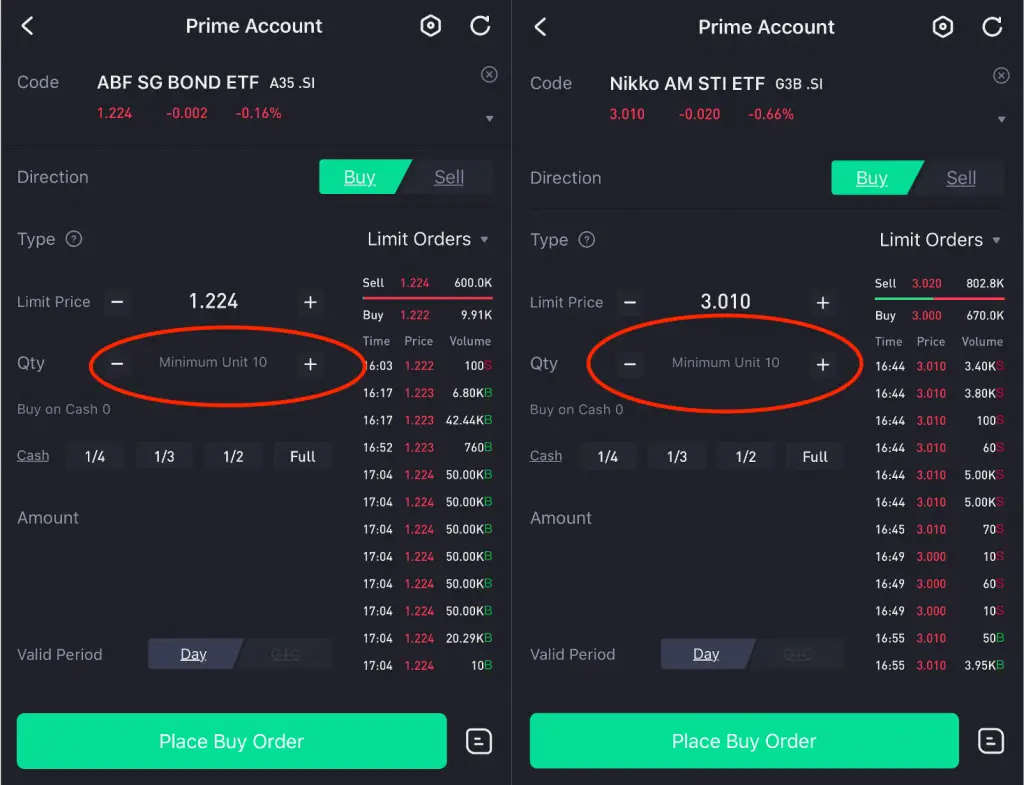
You’ll need to consider the trading commissions too
Besides the initial investment amounts, you’ll need to consider your trading commissions too.
When you make a trade with a broker, they will usually charge you a fee for each trade.
Some brokers may charge a minimum fee for each trade. If you are only able to invest a small amount of money, the fees are not worth it.
For example, OCBC Securities charges a minimum commission of $25 when you trade in the SGX. The amount you pay in fees is almost the same as your investment amount!
You may want to consider Tiger Brokers, which charges only 0.08% of your trade amount, with no minimum! The ‘no minimum’ promotion is valid until 30 April 2021.
You can invest in both ETFs using Cash, SRS or CPF
You are able to invest in both ETFs using your SRS or CPF funds as well.
For SRS, you are able to invest in any ETFs which are listed on the SGX.

Some brokers which allow you to invest using your SRS funds include:
Both ETFs are also classified as ‘Low to Medium Risk’ by the CPF board.

As such, you are able to invest in both ETFs using your CPF funds.
You will need to find a broker that allows you to invest your CPF funds with them as well. Most of these brokers are the same as the ones that are listed above.
#2 Regular savings plans
Regular savings plans adopt a dollar-cost averaging approach to investing. This means that you are investing the same amount of money into the market every month.
When the price is higher, you will buy less units. When the price is lower, you will buy more units with the same investment amount.
In the end, the average price that you pay is somewhere between your highest and lowest prices.
There are 4 regular savings plans available in Singapore that let you invest in either or both of these ETFs.
| A35 | G3B | |
|---|---|---|
| OCBC BCIP | ✕ | ✓ |
| Invest Saver | ✓ | ✓ |
| POEMS Share Builders Plan | ✓ | ✕ |
| FSMOne RSP | ✕ | ✓ |
If you’re looking to dollar cost average into both ETFs, POSB’s Invest Saver may be the best option for you.
#3 Robo-Advisors (StashAway Income Portfolio)
Both bond ETFs are part of StashAway’s Income Portfolio.
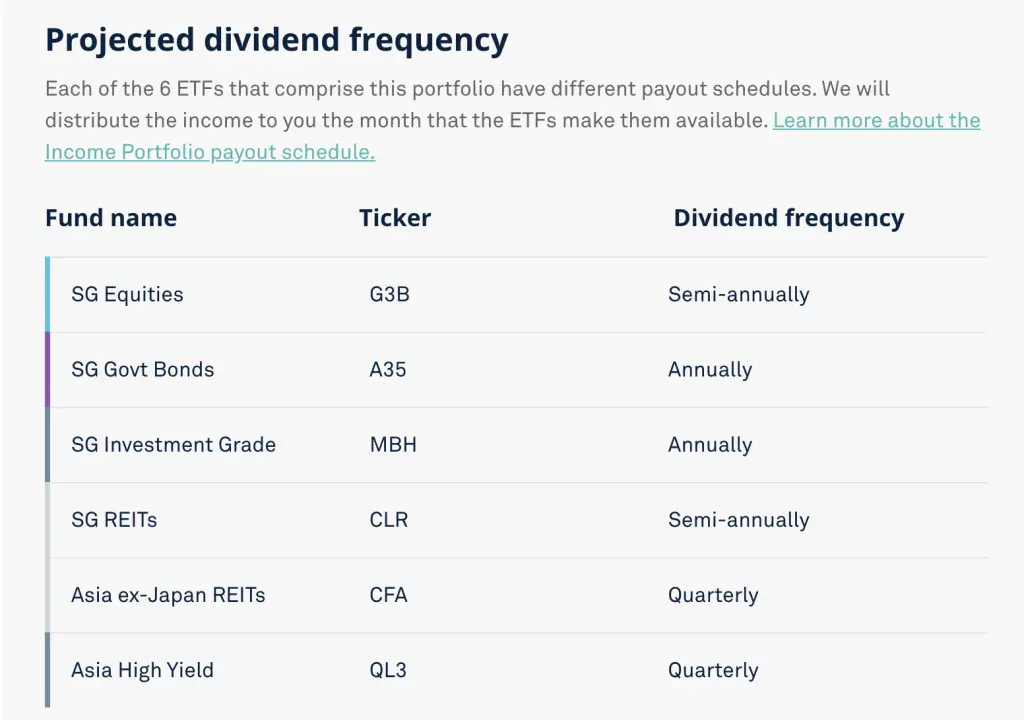
So far, this is the only robo-advisor that allows you to invest in these ETFs. However, you cannot invest into these 2 ETFs directly.
You will only invest a part of your portfolio into A35 and G3B.
Verdict
Here is a comparison between the ABF Bond ETF and the Nikko AM STI ETF:
| ABF Bond Index Fund | Nikko AM STI ETF | |
|---|---|---|
| Index Tracked | iBoxx ABF Singapore Bond Index | Straits Time Index |
| Fund Manager | Nikko AM | Nikko AM |
| AUM | $1,001 million | $512 million |
| Exchange | SGX | SGX |
| Estimated Unit Prices | $1 | $3 |
| Dividend Distribution | Annually | Half-Yearly |
| Expense Ratio | 0.25% | 0.30% |
| Average Trading Volume | 389,000 | 454,000 |
| Methods to Invest | Brokers | Brokers |
| Funds to Invest | Cash SRS CPF | Cash SRS CPF |
So which of the ETFs should you choose? I feel that this really depends on 2 factors:
So here’s what I would recommend you to choose:
Invest in the STI ETF if you have a larger risk appetite
If you are able to take a higher risk and have a longer horizon, then the STI ETF will be the better choice.
The STI ETF will provide you with higher returns overall. However, it will have more volatility compared to the ABF fund.
Invest in the ABF Bond Fund if you have a lower risk appetite
If you are not willing to take a lot of risks, the ABF Bond Fund may be a better option for you.
This is because the ABF Bond fund invests in bonds, which are fixed income products.
You will have lower returns compared to the STI ETF. However, your returns will be more stable!
This makes it less of a risk compared to investing in the STI ETF, which invests in stocks.
Conclusion
The ABF Bond ETF and Nikko STI ETF will both help you to achieve various financial goals. It is even possible to invest in both of them as well!
As such, you’ll need to decide which one is better to invest in based on your time horizon and risk profile.

Do you like the content on this blog?
To receive the latest updates from my blog and personal finance in general, you can follow me on my Telegram channels (Personal Finance or Crypto) and Facebook.
Are you passionate about personal finance and want to earn some flexible income?

